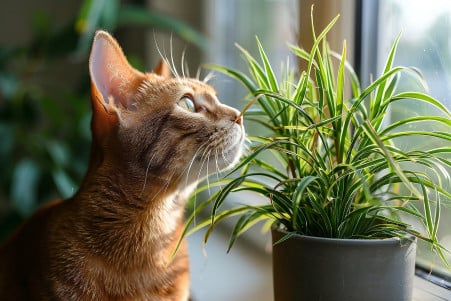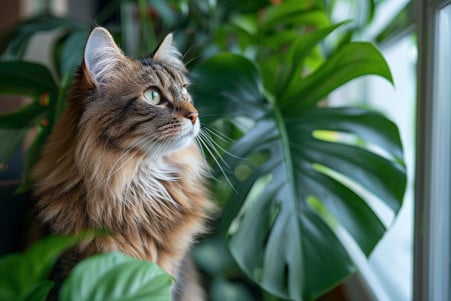Can Cats Be Around Snake Plants? Risks and Safety Measures
24 February 2024 • Updated 24 February 2024

If you’re a cat owner, you may have wondered whether snake plants are safe to keep in your home. The saponins in snake plants (Sansevieria trifasciata) are toxic to cats. If cats consume snake plants, they can suffer from vomiting, diarrhea, and other signs of stomach upset. To protect your cats, either keep snake plants in a place that’s inaccessible to them or choose a non-toxic plant like a spider plant.
To better understand the relationship between snake plants and cats, this article will review the relevant literature in horticulture, veterinary toxicology, and animal behavior. Together, these fields of study offer a well-rounded view of the risks snake plants pose to cats, the symptoms of snake plant poisoning in cats, and the best ways to avoid any issues.
The article will also cover alternative plants that can add some greenery to your home without putting your inquisitive feline friends in harm’s way.
Can cats be around snake plants?
Why Are Snake Plants Toxic to Cats?
The organic compounds in snake plants, saponins, have a dual toxicity mechanism. On a biochemical level, they cause the breakdown of cell membranes, which can lead to gastrointestinal distress in cats.
If a cat eats any part of a snake plant, it can experience symptoms like drooling, vomiting, diarrhea, and loss of appetite, according to the Pet Poison Helpline. If you think your cat has eaten part of a snake plant, it’s important to watch for these signs and talk to a vet as soon as possible.
Saponin poisoning is diagnosed based on these symptoms and treatment is typically symptomatic and supportive. However, according to the Toxins journal, there is no specific treatment for saponin poisoning. The long-term effects of cats eating small amounts of snake plant over time could lead to ongoing problems like gastrointestinal upset or more general issues as a result of ongoing cellular damage.
Start by removing the plant material from your cat’s environment and cleaning its mouth. However, it’s important to see a vet to ensure that the poisoning is managed properly and to avoid a repeat incident, which will help ensure that your home continues to be a safe place for your inquisitive cat.
How to Protect Your Cat: Tips for Preventing Snake Plant Poisoning
The first step in preventing snake plant poisoning in cats is to keep these plants out of their reach. The Wildest recommends elevating plants on high shelves or using hanging baskets to help keep your cat away from the plant.
You can also simply keep your cat out of rooms where toxic plants are kept. If you want to avoid the risk altogether, Pet Health Network’s Dr. Justine A. Lee suggests opting for non-toxic plants like spider plants, which are safe for cats.
You can also use deterrents like citrus sprays, which most cats don’t like, or place decorative aluminum foil around the plant base to make it less appealing to your cat.
Keeping your cat entertained with toys, scratching posts, and cat trees is also important, according to The Wildest and Cat Health. You can even create a ‘cat garden’ with cat-friendly plants like catnip or kitty grass to give your cat a safe and appropriate outlet for their grazing behavior.
Make sure everyone in your household is aware of the risks of toxic plants to pets so that you can be sure your preventive measures are consistently followed. With these steps in place, you can enjoy the many benefits of houseplants while keeping your cat safe.
How to Identify and Treat Poisoning Symptoms
When it comes to snake plant poisoning in cats, it’s important to be able to identify symptoms as soon as possible. Cats can experience symptoms like drooling, vomiting, diarrhea, and nausea, according to Spruce Pets.
If your cat starts to show any of these symptoms after being in contact with a snake plant, it’s important to act quickly and calmly. First aid steps include preventing the cat from grooming itself to avoid further ingestion of the toxins and encouraging the cat to drink water to help dilute the contents of the stomach.
It’s important not to induce vomiting unless you have been instructed to do so by a veterinarian, as this can make the irritation of the gastrointestinal tract worse. International Cat Care notes that you should seek veterinary help immediately, and that treatment will likely include fluid therapy, antiemetic drugs, and supportive care.
Seeking help from a veterinarian as soon as possible is important not only to treat the immediate symptoms but also to prevent the long-term health problems that were discussed in the research on saponin toxicity. Knowing these steps can help cat owners keep their pets safe and healthy so that they can continue to be a part of the family.
Why Cats Are So Drawn to Houseplants
Cats are naturally curious animals, and their interest in houseplants like the snake plant can be attributed to a number of instincts they inherited from their wild ancestors. The Wildest says that cats may chew plants as a form of play, due to boredom, or even to help with their digestion.
To help curb these natural instincts, cat owners can provide their pets with other plant-based options like catnip or cat grass, which are safe and can help satisfy their desire to graze.
While cats love to play with plants, people can also benefit from their relationship with their greenery. Healthline points out that indoor plants can help reduce stress, a claim that is backed up by studies that show that the presence of plants can lead to improved focus and well-being.
To make sure that the benefits of plants for people don’t come at the expense of pets, it’s important to make sure that you’re picking out non-toxic plants and that you’re creating an environment for cats that’s full of stimulation, including fun toys and safe plants.
By understanding why cats are so interested in plants and the ways that plants can benefit people, you can create an environment that’s good for the well-being of both your cats and yourself.
How to Keep Your Cats Safe
So, snake plants are definitely a danger to cat owners. Sansevieria trifasciata has saponins, which A-Z Animals and The Spruce Pets list as a cat toxin.
If your cat has ingested any part of the snake plant and is showing signs like vomiting, lethargy, and diarrhea, you should get them to a vet as soon as possible. To avoid this, move the plant and replace it with something that is safe for your cat, like a spider plant or a Boston fern, to make sure that your home is a safe place for both you and your pets.
It’s so important to make sure that you are aware of the dangers and that you are doing everything that you can to keep your pets safe and healthy. This includes making sure that you have a safe home for your pets and that you are aware of the plants that you are bringing into your home.
If something does happen, the ASPCA and Pet Poison Helpline are both great resources for immediate help. So, in the end, it’s up to us to make sure that we are creating a safe and loving environment for our pets.
By continuing to learn and making sure that we are choosing our plants carefully, we can make sure that we are keeping a happy balance in our homes for both our pets and ourselves.


